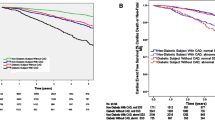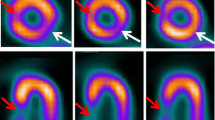Abstract
The field of nuclear cardiology has changed considerably over recent years, with greater attention paid to safety and radiation protection issues. The wider usage of technetium-99m (Tc-99m)-labeled radiopharmaceuticals for single-photon emission computed tomography (SPECT) imaging using gamma cameras has contributed to better quality studies and lower radiation exposure to patients. Increased availability of tracers and scanners for positron emission tomography (PET) will help further improve the quality of studies and quantify myocardial blood flow and myocardial flow reserve, thus enhancing the contribution of non-invasive imaging to the management of coronary artery disease. The introduction of new instrumentation such as solid state cameras and new software will help reduce further radiation exposure to patients undergoing nuclear cardiology studies. Results from recent studies, focused on assessing the relationship between best practices and radiation risk, provide useful insights on simple measures to improve the safety of nuclear cardiology studies without compromising the quality of results.
Similar content being viewed by others
References
ICRP, 2004. Managing patient dose in digital radiology. ICRP Publication 93. Ann. ICRP 34.
National Council on Radiation Protection and Measurements. Ionizing radiation exposure of the population of the United States. NCRP Rep. No. 160, NCRP, Bethesda, MD (2009).
Mettler FA Jr, et al. Medical radiation exposure in the US in 2006: preliminary results. Health Phys. 2008;95:502–7.
Mercuri M, Pascual TN, Mahmarian JJ, et al. Estimating the reduction in the radiation burden from nuclear cardiology through use of stress-only imaging in the United States and worldwide. JAMA Intern Med. 2016;176:269–73.
Mercuri M, Pascual TN, Mahmarian JJ, et al. Comparison of radiation doses and best-practice use for myocardial perfusion imaging in US and non-US laboratories: findings from the IAEA (International Atomic Energy Agency) Nuclear Cardiology Protocols Study. JAMA Intern Med. 2016;176:266–9.
Einstein AJ, Berman DS, Min JK, et al. Patient-centered imaging: shared decision making for cardiac imaging procedures with exposure to ionizing radiation. J Am Coll Cardiol. 2014;63:1480–9.
Einstein AJ, Blankstein R, Andrews H, et al. Comparison of image quality, myocardial perfusion, and left ventricular function between standard imaging and single-injection ultra-low-dose imaging using a high-efficiency SPECT camera: the MILLISIEVERT study. J Nucl Med. 2014;55(9):1430–7. doi:10.2967/jnumed.114.138222 Epub 2014 Jun 30.
Einstein AJ, Johnson LL, DeLuca AJ, et al. Radiation dose and prognosis of ultra-low-dose stress-first myocardial perfusion SPECT in patients with chest pain using a high-efficiency camera. J Nucl Med. 2015;56(4):545–51. doi:10.2967/jnumed.114.150664.
http://www.survey.unscear.org/lib/exe/fetch.php?media=unscear_user_manual_version_may2015.pdf. Accessed 21 Apr 2017.
Underwood SR, Godman B, Salyani S, et al. Economics of myocardial perfusion imaging in Europe—the EMPIRE Study. Eur Heart J. 1999;20:157–66.
Stowers SA, Eisenstein EL, Wackers FJ, et al. An economic analysis of an aggressive diagnostic strategy with single photon emission computed tomography myocardial perfusion imaging and early exercise stress testing in emergency department patients who present with chest pain but nondiagnostic electrocardiograms: results from a randomized trial. Ann Emerg Med. 2000;35:17–25.
Dondi M, Andreo P. Developing nuclear medicine in developing countries: IAEA’s possible mission. Eur J Nucl Med Mol Imaging. 2006;33:514–5.
http://iopscience.iop.org/article/10.1088/0952-4746/28/2/R02/pdf. Accessed 21 Apr 2017.
Wrixon AD. New ICRP recommendations. J Radiol Prot. 2008;28:161–8.
ICRP. General principles for the radiation protection of workers. ICRP Publication 75. Ann ICRP. 1997;27(1).
Malone J, Guleria R, Craven C, et al. Justification of diagnostic medical exposures: some practical issues. Report of an International Atomic Energy Agency Consultation. Br J Radiol. 2012;85(1013):523–38. doi:10.1259/bjr/42893576 Epub 2011 Feb 22.
Ronan G, Wolk MJ, Bailey SR, et al. ACCF/AHA/ASE/ASNC/HFSA/HRS/SCAI/SCCT/SCMR/STS 2013 multimodality appropriate use criteria for the detection and risk assessment of stable ischemic heart disease: a report of the American College of Cardiology Foundation Appropriate Use Criteria Task Force, American Heart Association, American Society of Echocardiography, American Society of Nuclear Cardiology, Heart Failure Society of America, Heart Rhythm Society, Society for Cardiovascular Angiography and Interventions, Society of Cardiovascular Computed Tomography, Society for Cardiovascular Magnetic Resonance, and Society of Thoracic Surgeons. J Nucl Cardiol. 2014;21(1):192–220.
Einstein AJ, Pascual TN, Mercuri M, For the INCAPS Investigators Group. Current worldwide nuclear cardiology practices and radiation exposure: results from the 65 country IAEA Nuclear Cardiology Protocols Cross-Sectional Study (INCAPS). Eur Heart J. 2015;36:1689–96.
Cerqueira MD, Allman KC, Ficaro EP, et al. Recommendations for reducing radiation exposure in myocardial perfusion imaging. J Nucl Cardiol. 2010;17:709–18.
Mercuri M, Pascual TN, Mahmarian JJ, For the INCAPS Investigators Group. Comparison of radiation doses and best-practice use for myocardial perfusion imaging in US and non-US laboratories: findings from the IAEA (International Atomic Energy Agency) Nuclear Cardiology Protocols Study. JAMA Intern Med. 2016;176:266–9.
Marcassa C, Zoccarato O, Calza P, Campini R. Temporal evolution of administered activity in cardiac gated SPECT and patients’ effective dose: analysis of an historical series. Eur J Nucl Med Mol Imaging. 2013;40:325–30.
IAEA Human Health Series No. 23 (Rev. 1) Nuclear Cardiology: guidance on the Implementation of SPECT myocardial perfusion imaging. International Atomic Energy Agency, Vienna; 2016.
Glover DK, Ruiz M, Edwards NC, et al. Comparison between 201Tl and 99mTc sestamibi uptake during adenosine-induced vasodilation as a function of coronary stenosis severity. Circulation. 1995;91:813–20.
Jerome SD, Tilkemeier PL, Farrell MB, Shaw LJ. Nationwide laboratory adherence to myocardial perfusion imaging radiation dose reduction practices: a report from the Intersocietal Accreditation Commission Data Repository. JACC Cardiovasc Imaging. 2015;8:1170–6.
Agostini D, Marie PY, Ben-Haim S, et al. Performance of cardiac cadmium-zinc-telluride gamma camera imaging in coronary artery disease: a review from the cardiovascular committee of the European Association of Nuclear Medicine (EANM). Eur J Nucl Med Mol Imaging. 2016;43:2423–32.
DePuey G. Advances in cardiac processing software. Semin Nucl Med. 2014;44:252–73.
Lecchi M, Malaspina S, Scabbio C, et al. Myocardial perfusion scintigraphy dosimetry: optimal use of SPECT and SPECT/CT technologies in stress-first imaging protocol. Clin Transl Imaging. 2016;4:491–8.
Salerno M, Beller G. Non-invasive assessment of myocardial perfusion. Circ Cardiovasc Imaging. 2009;5:412–24.
Shanoudi H, Raggi P, Beller G, et al. Comparison of technetium-99m tetrofosmin and thallium-201 single-photon emission computed tomographic imaging for detection of myocardial perfusion defects in patients with coronary artery disease. JACC. 1998;31:331–7.
http://imagewisely.org/~/media/ImageWisely-Files/NucMed/Myocardial-Perfusion-SPECT.pdf. Accessed 21 Apr 2017.
Chang SM, et al. Normal stress-only versus standard stress/rest myocardial perfusion imaging: similar patient mortality with reduced radiation exposure. J Am Coll Cardiol. 2010;55:221–30.
Glover DK, Gropler RJ. Journey to find the ideal PET tracer: are we there yet? J Nucl Cardiol. 2007;14:765–8.
Gould KL, Johnson NP, Bateman TM, et al. Anatomic versus physiologic assessment of coronary artery disease. Role of coronary flow reserve, fractional flow reserve, and positron emission tomography imaging in revascularization decision-making. J Am Coll Cardiol. 2013;62:1639–53.
Berman DS, Kang X, Slomka PJ, et al. Underestimation of extent of ischemia by gated SPECT myocardial perfusion imaging in patients with left main coronary artery disease. J Nucl Cardiol. 2007;14:521–8.
Yoshinaga K, Klein R, Tamaki N. Generator-produced rubidium-82 positron emission tomography myocardial perfusion imaging-from basic aspects to clinical applications. J Cardiol. 2010;55:163–73.
Camici PG, Kumak SP, Rimoldi O. Stunning, hibernation, and assessment of myocardial viability. Circulation. 2008;117:103–14.
Skali H, Schulman AR, Dorbala S. 18F-FDG PET/CT for the assessment of myocardial sarcoidosis. Curr Cardiol Rep. 2013;15:352.
Ohira H, Birnie DH, Pena E, et al. Comparison of 18F-fluorodeoxyglucose positron emission tomography (FDG PET) and cardiac magnetic resonance (CMR) in corticosteroid-naive patients with conduction system disease due to cardiac sarcoidosis. Eur J Nucl Med Mol Imaging. 2016;43:259–69. doi:10.1007/s00259-015-3181-8.
Nensa F, Kloth J, Tezgah E, et al. Feasibility of FDG-PET in myocarditis: comparison to CMR using integrated PET/MRI. J Nucl Cardiol. 2016. doi:10.1007/s12350-016-0616-y.
Jiménez-Ballvé A, Pérez-Castejón MJ, Delgado-Bolton RC, et al. Assessment of the diagnostic accuracy of 18F-FDG PET/CT in prosthetic infective endocarditis and cardiac implantable electronic device infection: comparison of different interpretation criteria. Eur J Nucl Med Mol Imaging. 2016;43:2401–12.
Schindler TH, Schelbert HR, Quercioli A, Dilsizian V. Cardiac PET imaging for the detection and monitoring of coronary artery disease and microvascular health. JACC Cardiovasc Imaging. 2010;3:623–40. doi:10.1016/j.jcmg.2010.04.007.
Author information
Authors and Affiliations
Corresponding author
Ethics declarations
Funding
No external funding was used in the preparation of this manuscript.
Conflicts of interest
Maurizio Dondi, Thomas N. Pascual, and Diana Paez declare that they have no conflict of interest that might be relevant to the contents of this manuscript. Andrew J. Einstein reports receiving research grants to Columbia University from GE Healthcare, Philips Healthcare, and Toshiba America Medical Systems.
Rights and permissions
About this article
Cite this article
Dondi, M., Pascual, T., Paez, D. et al. Nuclear Cardiology: Are We Using the Right Protocols and Tracers the Right Way?. Am J Cardiovasc Drugs 17, 441–446 (2017). https://doi.org/10.1007/s40256-017-0230-7
Published:
Issue Date:
DOI: https://doi.org/10.1007/s40256-017-0230-7




